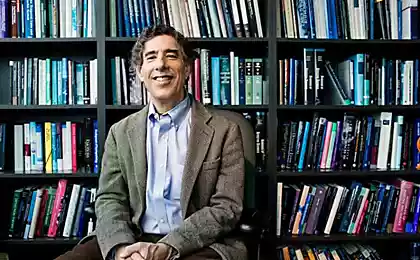677
Neuroplasticity: the Brain reflects our environment, our decisions, emotions and lifestyle
Our brains are extraordinarily plastic. Not like plastic dishes or doll Barbie in neuro plasticity means the amazing ability of the brain to change and adapt to almost everything that happens to us.
In times past, scientists believed that when a person ceased to be a child, his brain froze, like a clay pot, and stayed in one form. But piles studies have refuted their opinion – the brain is more like plasticine [play-doh]. These changes can occur at various scales ranging from individual neurons, changing connection, to a cortical region, shrinking or swelling.

The structure of the brain can change a variety of factors, from injuries and strokes, to meditation, exercise or daily practice on the piano. And like everything in life, plasticity is a double – edged sword:
Let's see how that happens and why.
Let's start with small scale and synaptic plasticity. This kind of plasticity, often referred to as long potentiala (DPTs) and prolonged suppression (DPD) that is crucial to our understanding of the processes of remembering and learning. Very simplistically it works like this: the connections between neurons are strengthened or weakened (occurs potentiate or depression) depending on their actions. When a neuron And constantly excites neuron B, the connection between them is enhanced.

Naturally, this usually occurs at multiple synapses – so can appear the whole network, if they are a sufficient amount of time in this format showed activity (and we believe that the memory is formed about the same). So kiss your sweetheart quite often while listening to songs Lou Bega, and soon the song "Mambo number five" will cause you a romantic feeling.
Donald Hebb [Donald Hebb's] canadian neuropsycholog, came up with the saying "start Together, braided together" [What fires together, wires together] to describe this process. Initially, these relationships are fragile but if you activate them enough times, they will become durable (they cannot be separated, as Britney and Justin in ' 99).
The reverse process, DPD, runs another procedure stimulation and is believed, reduces unnecessary when you forget the name of your ex or make new dance moves.
The plasticity of synapses – the concept that cognitive and behavioural therapists recommend their patients to change established thought patterns need step by step with practices to form new ones. And new ways are evolving from dirt roads to highways (which moves healthy behavior), and broken contours drift away into oblivion.
Plasticity on a large scale manifests itself differently. A growing number of studies show that the more you use a certain muscle, the greater the area of the brain for it allocates. For example, one study shows that while the area that controls finger movement, usually have the same size, it is not consistently. After five days of piano practice was found some quite visible changes in the motor areas of the cortex. The area that controls finger movement, expanded and occupied other parts of neighboring areas, like weeds growing in the garden. The researchers went even further: they showed that even if subjects thought about exercising, the effect was almost the same! Mental exercises have been equally effective in reorganizing the structure of the brain as physical.
Another example (which students neurologists heard, perhaps more often than people in the "Bible Belt" of the USA, where it is especially strong in Protestant fundamentalism about Jesus) is the London taxi drivers. Experienced taxi drivers who have to memorize a map of the capital, including tens of thousands of streets and dozens of attractions, have a large rear hippocampus – a brain structure responsible for spatial memory and orientation.
In the control group, drivers with constant and well-established routes, the hippocampus is of normal size. To prevent the usual comments like "correlation does not guarantee causation" (because, perhaps, the increased size of the hippocampus and taxi drivers has led to this work?), researchers have shown that the increase in volume of the hippocampus correlated positively with the time spent behind the wheel. The longer you drive, the more your brain adapts.

You already agree that the brain is incredibly plastic? Do not hurry, we have more examples. If you have opted out of meditation, as from the hippy nonsense, please note that long-term meditation practice is associated with very positive changes in the brain. Think of it as training – like piano lessons.
Studies show that if you sit quietly or pray, it is possible to increase the thickness of the cortex (i.e., more gray cells, i.e., more neurons for signal processing) in areas associated with attention, memory and managing emotions. Moreover, the amygdala, the center of the reactions associated with fear and aversion, diminishes and weakens the connection with the prefrontal cortex, the place where is the highest Executive functions. Simply put, prayer enables us to respond to stress more carefully and to suppress the instincts. Last on the line, but not in importance – network for passive mode of the brain responsible for self-determination and daydreaming, also reduces the activity, allowing less to escape (and prevent the leap of thought from yesterday's party on the inevitability of death or something like that).
And while I'm doing a hidden propaganda of healthy lifestyle, will mention that another change your brain for the better physical exercise. Three hours of brisk walking per week improves the growth and birth of nerve cells, which in turn prevents age-related decrease of the brain. The study shows that especially benefit from this front region and the hippocampus – that is, their volume after a long exercise grew. Here you have an example of how memory and reasoning powers improve with a healthy lifestyle.

Your brain, like the perfect spouse there with you together in good times and in bad, in sickness and in health. After the trauma or stroke neuroplasticity helps you. Rehabilitation training after stroke or injury has shown that the brain is reorganizing around the damaged region. For example, a stroke has damaged part of the brain responsible for movement of the left hand.
The use of the technology called "therapy of forced motor limit" (when you are forced to use "bad" hand, while his other hand restrict the motions) leads to an increase in the volume of gray matter in the motor Department, changes adjacent to the damaged regions so that they take over and even force of the contralateral hemisphere to participate in the recovery. The brain rearranges itself to adapt to new circumstances and make the best of it.
However, there is so great. Sometimes the brain can put a pig and give you trouble – this is me about phantom pain. You have probably heard about people who have retained the feeling of amputated hands or feet. It is also a merit of our restless plastic brain, although 100% of this process has not been studied.
One of the accepted theories says that the area of the somatosensory cortex adjacent to one that was responsible for the functions of missing limbs, grabs a new opportunity and takes the vacant place. For example, the face area is located near the area of the hands. And if you lose the hand, the face takes the place of your neighbor and perceives all the sensations of a person doubly as coming from his cheeks, and from the non-existent thumb.

Also interesting: the Brain and Happiness: How to change your feelings and behavior
The autistic brain: thinking across the spectrum
It becomes clear that we are not limited to the cards that we were given by nature: it is possible to change some of them (and it won't be perceived as cheating). The brain reflects our environment, our decisions, emotions and lifestyle, and to change all this, in fact, never too late. published
Author: Vyacheslav Golovanov
Source: geektimes.ru/post/280138/
In times past, scientists believed that when a person ceased to be a child, his brain froze, like a clay pot, and stayed in one form. But piles studies have refuted their opinion – the brain is more like plasticine [play-doh]. These changes can occur at various scales ranging from individual neurons, changing connection, to a cortical region, shrinking or swelling.

The structure of the brain can change a variety of factors, from injuries and strokes, to meditation, exercise or daily practice on the piano. And like everything in life, plasticity is a double – edged sword:
- Plus the fact, that the brain can reorganize itself during rehabilitation after stroke.
- Minus – the phantom pain after losing a limb.
Let's see how that happens and why.
Let's start with small scale and synaptic plasticity. This kind of plasticity, often referred to as long potentiala (DPTs) and prolonged suppression (DPD) that is crucial to our understanding of the processes of remembering and learning. Very simplistically it works like this: the connections between neurons are strengthened or weakened (occurs potentiate or depression) depending on their actions. When a neuron And constantly excites neuron B, the connection between them is enhanced.

Naturally, this usually occurs at multiple synapses – so can appear the whole network, if they are a sufficient amount of time in this format showed activity (and we believe that the memory is formed about the same). So kiss your sweetheart quite often while listening to songs Lou Bega, and soon the song "Mambo number five" will cause you a romantic feeling.
Donald Hebb [Donald Hebb's] canadian neuropsycholog, came up with the saying "start Together, braided together" [What fires together, wires together] to describe this process. Initially, these relationships are fragile but if you activate them enough times, they will become durable (they cannot be separated, as Britney and Justin in ' 99).
The reverse process, DPD, runs another procedure stimulation and is believed, reduces unnecessary when you forget the name of your ex or make new dance moves.
The plasticity of synapses – the concept that cognitive and behavioural therapists recommend their patients to change established thought patterns need step by step with practices to form new ones. And new ways are evolving from dirt roads to highways (which moves healthy behavior), and broken contours drift away into oblivion.
Plasticity on a large scale manifests itself differently. A growing number of studies show that the more you use a certain muscle, the greater the area of the brain for it allocates. For example, one study shows that while the area that controls finger movement, usually have the same size, it is not consistently. After five days of piano practice was found some quite visible changes in the motor areas of the cortex. The area that controls finger movement, expanded and occupied other parts of neighboring areas, like weeds growing in the garden. The researchers went even further: they showed that even if subjects thought about exercising, the effect was almost the same! Mental exercises have been equally effective in reorganizing the structure of the brain as physical.
Another example (which students neurologists heard, perhaps more often than people in the "Bible Belt" of the USA, where it is especially strong in Protestant fundamentalism about Jesus) is the London taxi drivers. Experienced taxi drivers who have to memorize a map of the capital, including tens of thousands of streets and dozens of attractions, have a large rear hippocampus – a brain structure responsible for spatial memory and orientation.
In the control group, drivers with constant and well-established routes, the hippocampus is of normal size. To prevent the usual comments like "correlation does not guarantee causation" (because, perhaps, the increased size of the hippocampus and taxi drivers has led to this work?), researchers have shown that the increase in volume of the hippocampus correlated positively with the time spent behind the wheel. The longer you drive, the more your brain adapts.

You already agree that the brain is incredibly plastic? Do not hurry, we have more examples. If you have opted out of meditation, as from the hippy nonsense, please note that long-term meditation practice is associated with very positive changes in the brain. Think of it as training – like piano lessons.
Studies show that if you sit quietly or pray, it is possible to increase the thickness of the cortex (i.e., more gray cells, i.e., more neurons for signal processing) in areas associated with attention, memory and managing emotions. Moreover, the amygdala, the center of the reactions associated with fear and aversion, diminishes and weakens the connection with the prefrontal cortex, the place where is the highest Executive functions. Simply put, prayer enables us to respond to stress more carefully and to suppress the instincts. Last on the line, but not in importance – network for passive mode of the brain responsible for self-determination and daydreaming, also reduces the activity, allowing less to escape (and prevent the leap of thought from yesterday's party on the inevitability of death or something like that).
And while I'm doing a hidden propaganda of healthy lifestyle, will mention that another change your brain for the better physical exercise. Three hours of brisk walking per week improves the growth and birth of nerve cells, which in turn prevents age-related decrease of the brain. The study shows that especially benefit from this front region and the hippocampus – that is, their volume after a long exercise grew. Here you have an example of how memory and reasoning powers improve with a healthy lifestyle.

Your brain, like the perfect spouse there with you together in good times and in bad, in sickness and in health. After the trauma or stroke neuroplasticity helps you. Rehabilitation training after stroke or injury has shown that the brain is reorganizing around the damaged region. For example, a stroke has damaged part of the brain responsible for movement of the left hand.
The use of the technology called "therapy of forced motor limit" (when you are forced to use "bad" hand, while his other hand restrict the motions) leads to an increase in the volume of gray matter in the motor Department, changes adjacent to the damaged regions so that they take over and even force of the contralateral hemisphere to participate in the recovery. The brain rearranges itself to adapt to new circumstances and make the best of it.
However, there is so great. Sometimes the brain can put a pig and give you trouble – this is me about phantom pain. You have probably heard about people who have retained the feeling of amputated hands or feet. It is also a merit of our restless plastic brain, although 100% of this process has not been studied.
One of the accepted theories says that the area of the somatosensory cortex adjacent to one that was responsible for the functions of missing limbs, grabs a new opportunity and takes the vacant place. For example, the face area is located near the area of the hands. And if you lose the hand, the face takes the place of your neighbor and perceives all the sensations of a person doubly as coming from his cheeks, and from the non-existent thumb.

Also interesting: the Brain and Happiness: How to change your feelings and behavior
The autistic brain: thinking across the spectrum
It becomes clear that we are not limited to the cards that we were given by nature: it is possible to change some of them (and it won't be perceived as cheating). The brain reflects our environment, our decisions, emotions and lifestyle, and to change all this, in fact, never too late. published
Author: Vyacheslav Golovanov
Source: geektimes.ru/post/280138/























